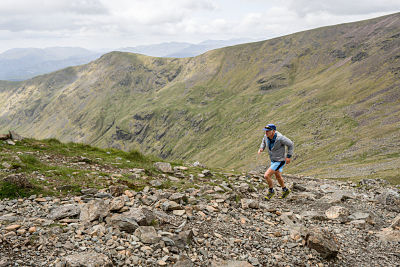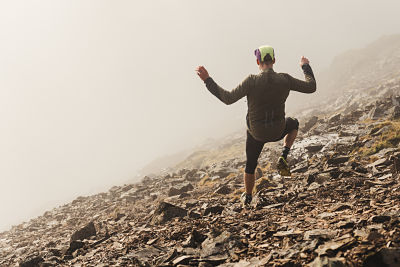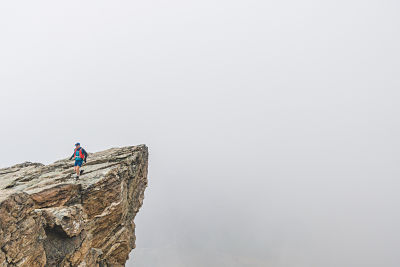I'm lucky enough to work with lots of different runners each year. Most of that work is either leading people in the mountains or preparing people for mountain races, and one question crops up more than any other during our breathless conversations: “how do I get better at running in the hills?”.
How to train for hill races
If I'm feeling particularly facetious then my answer to anyone who’s looking for advice on improving their hill running would be, “go and run in the hills…”. For those of us living in hilly areas, this is pretty much as advanced as it needs to get, but this advice is less than helpful for many people.
In fact, most of the runners I work with come from distinctly un-hilly areas but that doesn't stop them running events like the Bob Graham Round or Ultra Trail du Mont Blanc. For those athletes, it requires a bit less facetiousness from me and a bit more planning and forethought.

Improve your overall fitness on the flat
Simply getting fitter will help you on the uphill sections. Even if you’re not training in the hills, running consistently and slowly improving your fitness on the flats will allow your aerobic system to adjust when you get into more mountainous terrain.
Ultimately, the fitter you are, the quicker you will be able to gallop (or crawl) to the top of that hill.
Of course, there are other considerations - for example, there’s greater stress on your ankles and calves, and there will be greater glute activation, but these problems are not usually big roadblocks for people and can be worked on over a short amount of time.
It’s downhill running where people’s anxieties usually lie, and rightly so. If you’re lacking fitness then you will just go a bit slower on the uphills - you might not get the results you're looking for, but it’s manageable.
On the other hand, if your legs are not conditioned for the downhills, that can be a race-ender. Running downhill is basically a muscular problem that we need to solve, but how do we solve these problems if we live in the 'flatlands'?

Build towards specificity
I advise people not stress too much about training specifically for hills until about 10 - 8 weeks before an event. Adaptation to running downhill (eccentric loading - ie. the active lengthening of the muscle) takes a relatively short amount of time and as mentioned above, your normal training will do a lot to prepare you for the uphills.
So when the more race-specific period of training begins, there are a few strategies that you could deploy.
Look at elevation gain and loss in relation to your race. The usual question that gets asked by athletes is, “how much elevation do I need to do per week?”.
Focus on your upcoming event and its demands per kilometre. Let's say you're training for the Orsières-Champex-Chamonix (OCC), a 56km race with 3500m of 'vert'.
Take the overall elevation change (7000m) and divide by the race distance (56km) which would give you the amount of elevation change - in this example, 125m. From this basic calculation, for every 1km in training you should aim to run 125m of elevation change. So if you go out and run 10km, the aim would be to build in 625m of up and 625m of down.
This might be a challenge to do during every session, so focus on finding those routes at the weekend and try to work towards an average elevation during your key runs.

Even in the flattest of flatlands we usually have a trail network or small ‘lump’ not too far away, so if you can get away on the weekends to do your long runs on trails that allow you to meet the profile of your race, then you’re on to a winner.
Even doing hill repeats on tiny inclines is useful. I'm not talking about hard hill intervals, but just running at endurance intensity up and down the hill.
I work with a runner who lives near Oxford and last weekend she ran up and down the same 75-metre hill 12 times over 2 hours - that’s dedication, right? Even though her event involves longer climbs, she attempted to replicate her race scenario with the terrain she had on her doorstep.
Training camps
Travel is a bit difficult at the moment, but things will get easier, and one of the best ways of preparing for a hilly race is to go on a training camp 4-6 weeks before your event.
Even one bout of eccentric training has been shown to have lasting protective effects for weeks afterwards.
Run your sessions during the camp at a normal endurance pace, practice running efficiently downhill by ‘running quietly’ and looking ahead rather than right at your feet. This coupled with a few outings to your local trail network or small 50-metre hill will do wonders for your legs.
If available, you could also try doing a few of your easy runs on a treadmill that has a descending option.
Strength and conditioning exercises
You can also incorporate exercises into your strength and conditioning program (bodyweight or low weight only) that focus on eccentrically loading the quads. I came across David Roche's great workout below on YouTube which I always recommend and have been using for years.
You’ll notice that I haven’t spent too much time talking about strength and conditioning and there's a reason for that.
I’m a big believer that running should take centre stage. Don't get me wrong, you should use strength training to keep your body in check, especially if you have known weaknesses or recurring injuries, but the factor that will have the biggest impact on your hill running is running on the right terrain.

My advice to anyone training for any race is to train with this ethos in mind: least specific to most specific. Meaning that the closer you get to race day the more your training should try and replicate the challenges and conditions of the race.
The biggest takeaway is that you don't need to be smashing hill sessions every day to run hilly races. Your general running fitness is a massive indicator of how well you will perform in the hills and the specific adaptations you'll need can be made over a relatively short time - so, 'flatlanders', there is hope!
